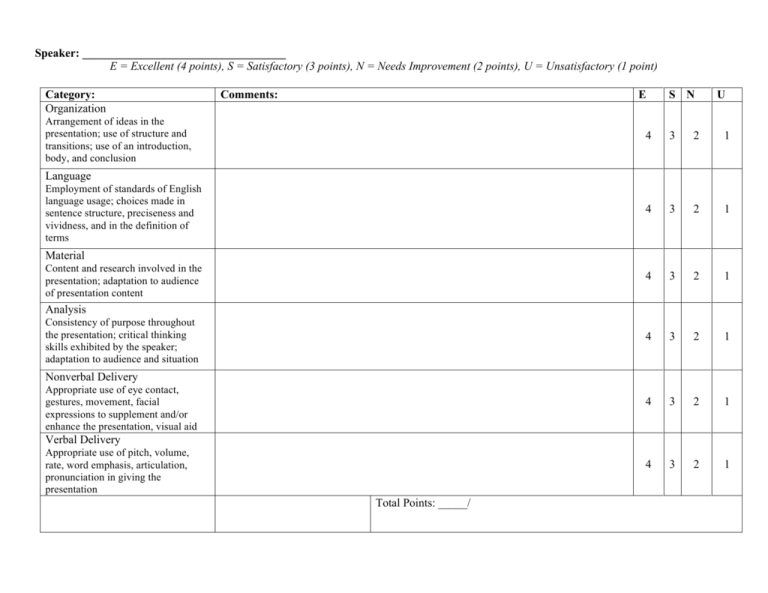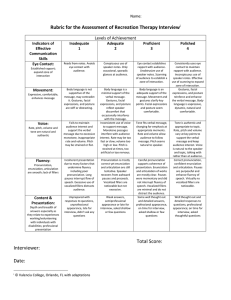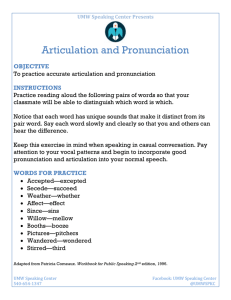Speaker: E = Excellent (4 points), S = Satisfactory (3 points), N
advertisement

Speaker: ___________________________________ E = Excellent (4 points), S = Satisfactory (3 points), N = Needs Improvement (2 points), U = Unsatisfactory (1 point) Category: Organization Comments: E Arrangement of ideas in the presentation; use of structure and transitions; use of an introduction, body, and conclusion S N U 4 3 2 1 4 3 2 1 4 3 2 1 4 3 2 1 4 3 2 1 4 3 2 1 Language Employment of standards of English language usage; choices made in sentence structure, preciseness and vividness, and in the definition of terms Material Content and research involved in the presentation; adaptation to audience of presentation content Analysis Consistency of purpose throughout the presentation; critical thinking skills exhibited by the speaker; adaptation to audience and situation Nonverbal Delivery Appropriate use of eye contact, gestures, movement, facial expressions to supplement and/or enhance the presentation, visual aid Verbal Delivery Appropriate use of pitch, volume, rate, word emphasis, articulation, pronunciation in giving the presentation Total Points: _____/ Primary Trait Analysis for Speaking Matrix for Assessment of Oral Presentations Organization Language Material Highly Competent Competent Minimally Competent Not Competent Main points are balanced, divided logically into sub-points, and clearly related to topic; well organized with introduction, body, conclusion; effective transitions are included between introduction and body, between the body and conclusion, and between the main points; introduction includes effective attention-getter, thesis, statement of credibility, statement of relevance; conclusion includes summary and closure. Language is conducive for oral presentation resulting in a fluent speech; consistently used creative and memorable sentence structure and word choice; concrete, descriptive language is used; vocabulary is appropriate, slang and jargon are avoided or defined. Conveyed a central idea or topic; most information presented in logical structure; adequate introduction, body, conclusion; adequate transitions. Attempted to focus on an idea or topic; ideas were loosely connected to topic; structure unclear; introduction, body, conclusion detectable but not comprehensive; transitions unclear. Had little or no focus on central idea or topic; no apparent logical structure; introduction, body, or conclusion absent; lacked transitions. Used some varied sentence structure and word choice; unfamiliar terms easily interpreted; adequate standards of usage employed; minor fluency hiccups due to language choice. Inadequate standards of usage; no varied sentence structure and word choice; unfamiliar terms not defined. Five clear, complete oral citations were included in the speech; content was specific to the topic, sources were credible, relevant, and interesting; sufficient material was cited to support each main point. Oral citations were clearly present but may lack minor details; content adequately specific, credible, relevant, sufficient, interesting; lacked support for some points; partial audience adaptation of content. Unfamiliar terms not easily interpreted; little varied sentence structure and word choice; minimal evidence of appropriate standards of usage; fluency hiccups due to language choice distracted from content. Some oral citations were missing or incomplete, content minimally specific, credible, relevant, sufficient, interesting; minimal support; little audience adaptation of content. Sources were not orally cited; content not specific, credible, relevant, sufficient, interesting; ideas not supported; lacks audience adaptation of content. Analysis Topic is made relevant to audience in the introduction and relevance is built throughout the body of the speech; Relevance is established for the specific audience; approach and structure highly consistent with overall purpose, logical progression and building of ideas; strong evidence of critical thinking. Nonverbal Delivery Did not read from notes and/or audio visual materials; clearly engaged audience through sweeping, deliberate eye contact, purposeful gestures/movement, and facial expressions appropriate for content. Verbal Delivery Voice varied in pitch, volume, rate, emphasis, inflection, and rhythm; appropriate enthusiasm; free of fillers (ahs, uhms, ers); highly effective articulation and pronunciation. Topic is made relevant to the audience in the introduction and in some other parts of the speech; relevance is established to a more general audience than the people present; approach and structure consistent with overall purpose; some evidence of critical thinking. Referred occasionally to notes and/or audio visual materials; engaged audience through eye contact, gestures/movement, and facial expressions. Attempt to establish relevance is made at one point in the speech; relevance is not established for a specific audience; approach and structure inconsistent with overall purpose; inconsistent evidence of critical thinking. Limited adaptation to audience and situation; approach and structure not appropriate for the overall purpose; lacks evidence of critical thinking. Relied heavily on notes and/or audio visual materials; exhibited minimal awareness of audience; infrequent eye contact or gestures; some distracting mannerisms. Some variation in pitch, volume, rate, and emphasis; some fillers (ahs, uhms, ers); effective articulation and pronunciation. Limited variation in pitch, volume, rate, and emphasis; some distracting fillers (ahs, uhms, ers); minimally effective articulation and pronunciation. Read directly from notes and/or audio visual materials; exhibited little or no audience awareness, gestures, or eye contact; frequent, distracting mannerisms. No variation in pitch, volume, rate, or emphasis; fillers (ahs, uhms, ers) detract from the presentation; lack of clear articulation and pronunciation.


